Methi Dal is a flavorful and nutritious Indian lentil dish made with fresh fenugreek leaves and spices. This comforting dal is naturally vegan, gluten-free, and mildly spiced. Easy to prepare, it pairs perfectly with roti or rice and is ready in under an hour! It can be made in the Instant Pot or on the Stovetop.
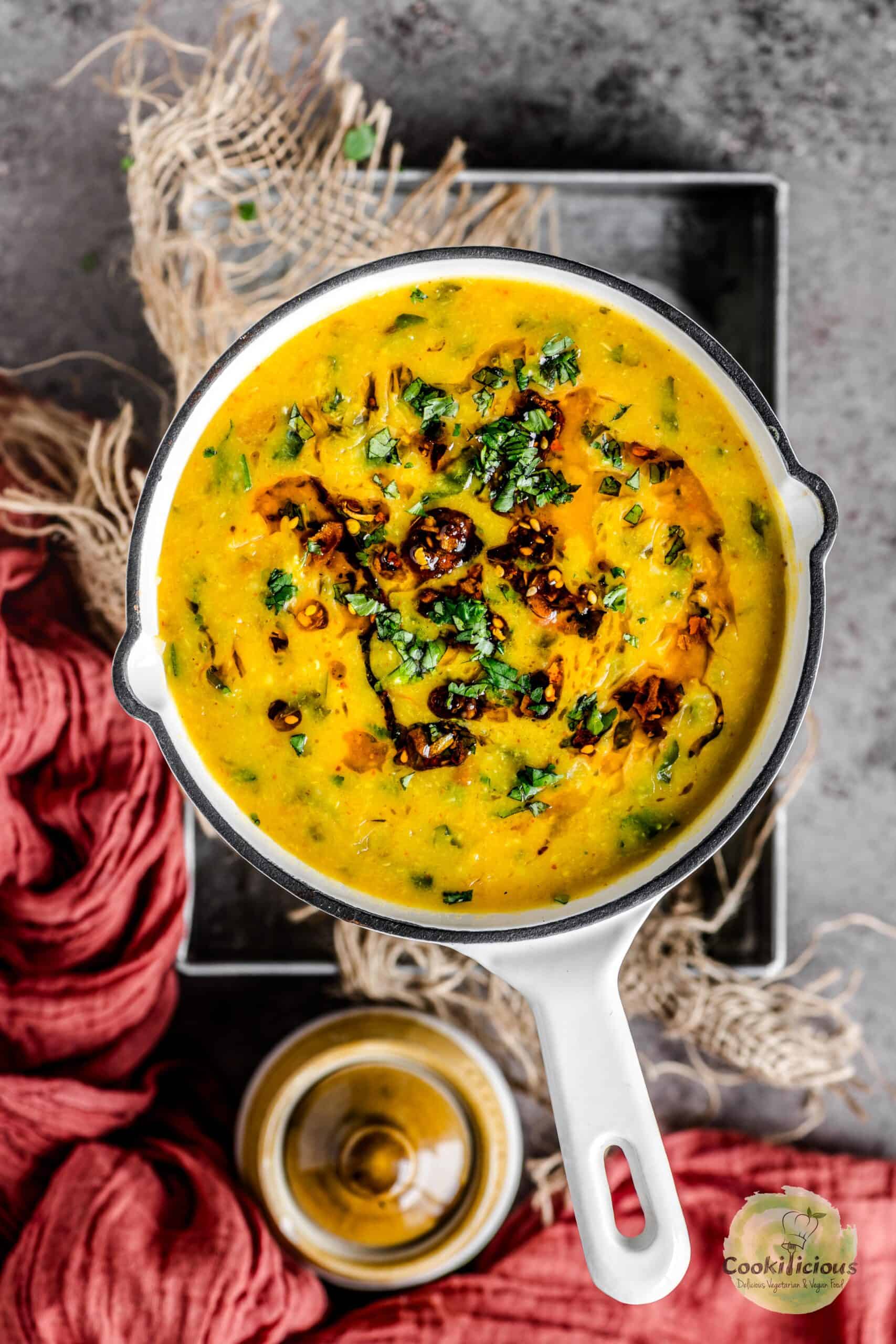
Jump to:
What Is Methi Dal
Methi Dal Fry is a flavorful Indian lentil stew made with protein-rich lentils, fresh methi (fenugreek) leaves, and aromatic spices. The slight bitterness of methi is beautifully balanced by the mild, comforting flavors of the lentils, making it a wholesome and satisfying dish. Combining lentils with greens is always a nutritious choice-just like Keerai, which pairs spinach with lentils for a hearty and nourishing meal.
This Indian-style lentil dish with fenugreek leaves is popular in Punjabi, Maharashtrian, and South Indian cuisine. It is also commonly served in Dhabas and restaurants across India. Methi wali dal is incredibly easy to prepare at home and serves as a delicious variation of the everyday Tadka Daal, making it perfect for weekly meal planning.
Growing up, Methi Daal was a staple in our home. My mom's version was always packed with flavor, and I've perfected it over the years to make it even simpler and nourishing in 40-45 minutes.
In Andhra cuisine, there's a similar South Indian dish called Menthi Kura Pappu that's made with fenugreek leaves. This dish features tamarind, which adds a tangy flavor that beautifully balances the slight bitterness of fenugreek leaves, making it a delicious and well-rounded lentil dish.
What Are Fenugreek Leaves
Fenugreek, or methi, is a widely used green leafy vegetable in Indian cuisine. It has a slightly bitter taste but is incredibly nutritious. Fenugreek is consumed in various forms-fresh leaves, seeds, and dried leaves (known as Kasuri Methi). While raw methi leaves have a strong, bitter flavor, but cooking them enhances their aroma and adds depth to the dish. In addition to its culinary uses, fenugreek is also valued for its medicinal properties. Some Indian recipes with fenugreek leaves on the blog are Aloo Methi Curry, Vegan Methi Matar Malai, and Ghavan.
Indian Dals - A Guide to Flavorful Lentil Dishes
While lentils have recently gained popularity in the West, they have been a staple in Indian cuisine for centuries. In India, the word Dal (Daal or Dhal)refers not only to pulses and lentils but also to the hearty, stew-like dish made from them.
Indian dal is a slow-cooked, soft, and mildly flavored lentil stew that is commonly enjoyed with rice. It's considered the ultimate comfort food. Every region, city, and even household in India has its own version of daal, influenced by local ingredients, seasons, and traditions. It's fascinating how a single ingredient-lentils-can be transformed into hundreds of unique and flavorful recipes across the country.
I absolutely love my Dal, which is why you'll find a variety of dhal recipes here. I enjoy exploring and featuring different lentil preparations from all over India, each with its own unique flavor and regional touch. You can check them out - Daal Tadka, Indian Lentil Soup, Sultani Daal, Shahjahani Dhal, Maa Ki Daal, Green Moong Daal Fry, and Kokum Amti.
Why Make It
- A great way to include lentils and fenugreek leaves in your daily diet
- Quick and easy recipe-ready in just 45 minutes, perfect for meal prep
- Can be made in the Instant Pot or on the stovetop
- No onion, no garlic - a Jain-friendly recipe
- Vegan, gluten-free, nut-free, and soy-free - perfect for all dietary needs
Ingredients needed 🧾
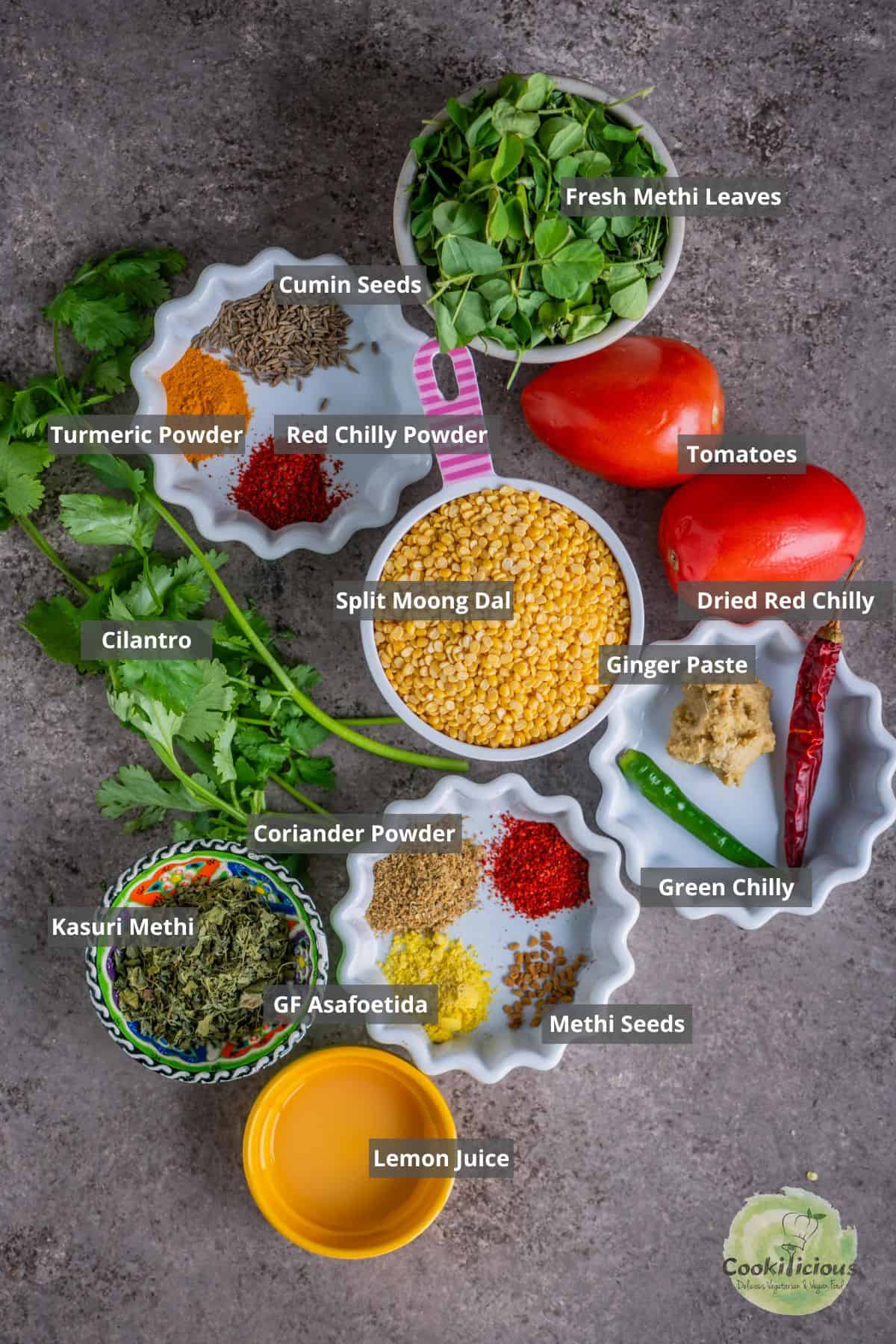
Fresh green fenugreek leaves are preferred for this recipe. Choose vibrant, non-wilted leaves, which you can find at any Indian grocery store. If fresh methi isn't available, frozen methi works as a great substitute. Besides fresh leaves, this Methi Tomato Dal recipe also includes fenugreek seeds and Kasuri methi (dried fenugreek leaves) to enhance the flavor.
For the lentils, I have used yellow split moong dal in this vegan lentil dish. These lentils are commonly available at Indian grocery stores or on Amazon.
Tomatoes add a sweet yet tangy flavor to the methi moong dal recipe and help balance the slight bitterness of fenugreek.
To bring out the best flavors, a mix of herbs and spices is used, including cilantro, cumin seeds, ginger paste, dried red chilies, green chilies, turmeric powder, red chili powder, coriander powder, and gluten-free asafoetida (hing).
Ghee is traditionally an essential ingredient in any dal recipe, but since it's made from dairy, I use homemade vegan ghee to replicate the same aroma and taste while keeping this methi leaves recipe vegan. Lemon juice is another key ingredient that adds a refreshing tang to Fenugreek Dal.
How to make it 🔪

To Pressure Cook The Moong Dal
- Rinse the moong dal under running water until the water runs clear.
- In a pressure cooker, heat vegan ghee. Once hot, fry the cumin seeds and dried red chili until aromatic.

- Add the rinsed lentils to the pressure cooker.
- Mix in turmeric powder, red chilly powder, and salt.
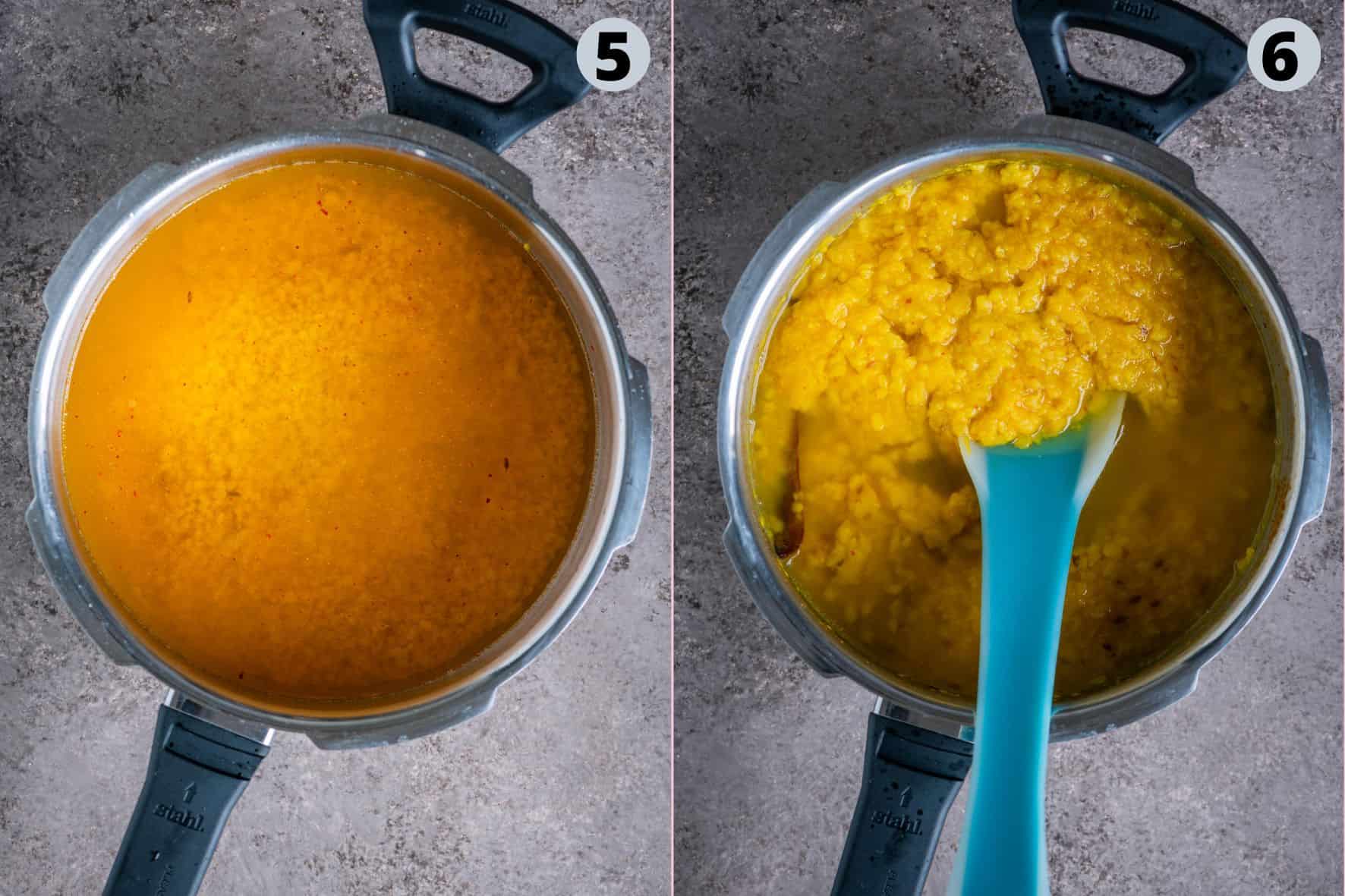
- Add water, mix well, and cover the pressure cooker. Cook for 3 whistles, which should take about 20 minutes.
- Once the pressure releases naturally, open the lid and mix. If the consistency is too thick, add water as needed. I added 2 cups of warm water to adjust the texture.
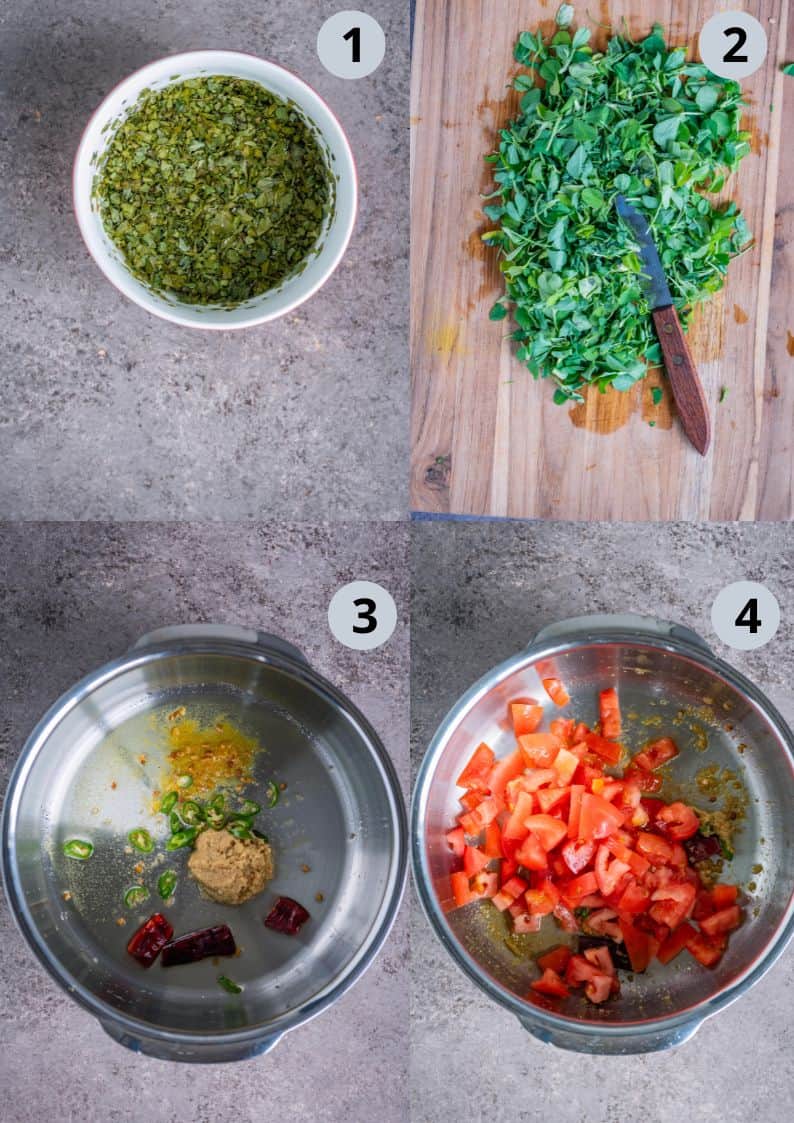
To Prepare Methi ki Dal
- Soak Kasuri methi in water for 10 minutes.
- Rinse the fresh fenugreek leaves, separate them from the stems, and chop finely. Discard the fibrous stems.
- Heat vegan ghee in a pan and sauté gluten-free asafoetida, methi seeds, ginger paste, broken dried red chili, and minced green chilies until aromatic.
- Add the chopped tomatoes and cook until they soften.
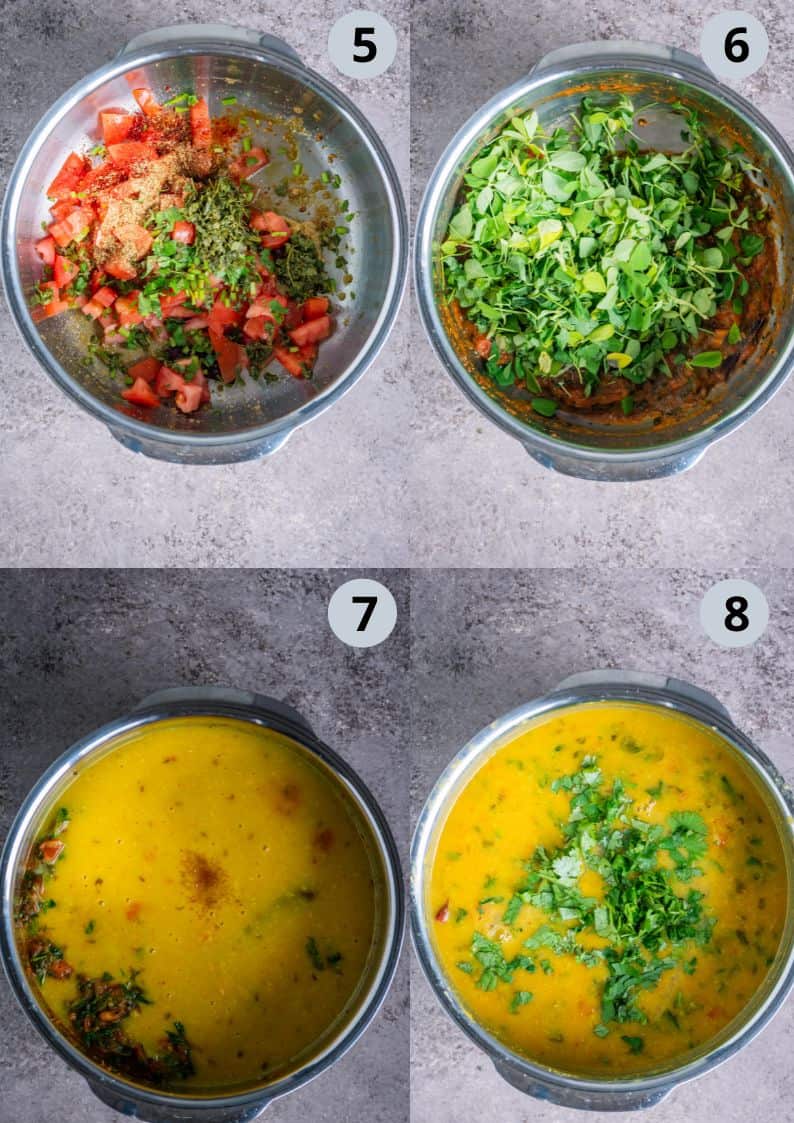
- Add chopped cilantro stalks, soaked Kasuri methi, turmeric powder, red chili powder, and salt. Mix well and cook until the tomatoes turn soft and pulpy, about 7-8 minutes. If the mixture starts sticking, add a little water.
- Stir in the methi leaves and sauté for 2-3 minutes to reduce their bitterness.
- Pour in the boiled moong dal and add water to adjust the consistency. Bring it to a boil. I added 1 cup of warm water. Mix in sugar and adjust salt as needed.
- Turn off the heat and garnish with chopped cilantro and lemon juice. Drizzle a teaspoon of vegan ghee, mix well.

🍽 Serving Suggestions
Methi Dal is now ready to be served! Drizzle some vegan ghee, sprinkle hemp hearts and chili oil for extra flavor and nutrition, or add a dash of amchur powder for a tangy twist. Serve it with roti, naan, chapati, steamed rice, Cauliflower rice, Quinoa, or Jeera Rice, or enjoy it as a soup or shorba. To make it a complete meal, pair it with steamed rice or roti and a side of Kurkuri Bhindi, Tendli Stir-Fry, Potato Fry, Aloo Gobi, Mushroom Pepper Fry, Dahi Bhindi, and Matki Usal. For the perfect finishing touch, complement the meal with Indian pickle, papad, chaas or raita for a truly satisfying experience.
💭 Priya's Recipe Tips
If fresh methi leaves are unavailable, you can use frozen methi. If the fenugreek leaves taste too bitter, sprinkle some salt over them and let them sit for 15 minutes, then squeeze out the excess water and discard it. You can also make this lentil stew using only Kasuri methi. For additional flavor, you may include curry leaves, onion, and garlic along with ginger paste. If you prefer a tangy taste, replace tomatoes with tamarind paste, kokum juice, or amchur powder. To enhance the dish's depth of flavor, add a teaspoon of Arhar Dal Masala while boiling the lentils.
Recipe FAQs
To store leftover Fenugreek Leaves Dal, keep it in an airtight container in the refrigerator, where it will stay fresh for 4-5 days. It can also be frozen-just thaw it overnight in the fridge and reheat it in the microwave or on the stovetop, adding warm water to adjust the consistency. Leftover Dal Methi can be repurposed in creative ways! Use it to make Savory Pancakes, blend it into a smooth and creamy Soup, or mix it with cooked rice to prepare a comforting Methi Dal Khichdi.
The ideal consistency of Dal Methi should be slightly thick yet pourable. Since it's made with moong dal, it tends to thicken as it sits. To adjust, gradually add warm water while reheating, but avoid making it too thin or runny. Always remember to adjust the salt accordingly when modifying the consistency.
Turn on the Instant Pot in sauté mode and sauté the ingredients as mentioned in the recipe. Then add water to adjust the consistency. Turn off the sauté mode, close the lid, and select manual/pressure cook mode. Set the valve to the sealing position and pressure cook for 8 minutes. Let the pressure release naturally for 10 minutes, then open the lid. Garnish with chopped cilantro and lemon juice, then mix well. Chef Tip - Adjust the consistency by adding warm water as needed.
Yes, you can use frozen fenugreek leaves for this Indian lentil dish. First, defrost the frozen methi leaves by leaving them on the counter for about an hour or in the refrigerator overnight. Once thawed, squeeze out any excess water before using them in the recipe.
Yes, methi leaves can be substituted with spinach to make Palak Dal. Other greens like baby kale, beet leaves, collard greens, mustard leaves, or mixed greens can also be used, each bringing a unique flavor and nutritional profile to the dish.
Instead of yellow moong dal, you can use chana dal, tur dal, masoor dal, or even a mix of different lentils. Each type of lentil will bring a unique texture and flavor to the dish. Keep in mind that cooking times may vary depending on the lentil variety, so adjust accordingly.
More Indian Dal Recipes

⭐️ Subscribe to the Cookilicious Newsletter and receive new recipes straight to your inbox! You'll receive my FREE Vegan Beginner's guide as a gift. Ready to elevate your cooking game? Purchase my Cookbook - The Essential Vegan Indian Cookbook today!
Recipe 📖

Easy Methi Dal Recipe
Equipment
Ingredients
To Cook The Moong Dal
- 1 tablespoon vegan ghee
- 1 teaspoon cumin seeds
- 1 dried red chilly
- 1 cup moong dal
- 1 teaspoon turmeric powder
- ½ teaspoon red chilly powder
- salt
- 3 cups water
To Prepare The Methi Dal
- 1 tablespoon vegan ghee
- ½ teaspoon GF asafoetida
- ⅛ teaspoon methi seeds
- 1 tablespoon ginger paste
- 1 green chilly, minced
- 1 broken dried red chilly
- 1 teaspoon coriander powder
- ½ teaspoon red chilly powder
- cilantro stalk, finely chopped
- 2 tomatoes, finely chopped
- 2 tablespoon Kasoori methi
- salt
- 1 cup fresh methi leaves
- 2 tablespoon cilantro
- ½ teaspoon sugar
- 1 tablespoon lemon juice
Instructions
To Pressure Cook The Moong Dal
- Rinse the moong dal under running water until the water runs clear.
- In a pressure cooker, heat vegan ghee. Once hot, fry the cumin seeds and dried red chili until aromatic.
- Add the rinsed moong dal to the pressure cooker.
- Mix in turmeric powder, red chilly powder, and salt.
- Add water, mix well, and cover the pressure cooker. Cook for 3 whistles, which should take about 20 minutes.
- Once the pressure releases naturally, open the lid and mix the dal. If the consistency is too thick, add water as needed. I added 2 cups of warm water to adjust the texture.
To Prepare Methi ki Dal
- Soak Kasuri methi in water for 10 minutes.
- Rinse the fresh fenugreek leaves, separate them from the stems, and chop finely. Discard the fibrous stems.
- Heat vegan ghee in a pan and sauté gluten-free asafoetida, methi seeds, ginger paste, broken dried red chili, and minced green chilies until aromatic.
- Add the chopped tomatoes and cook until they soften.
- Add chopped cilantro stalks, soaked Kasuri methi, turmeric powder, red chili powder, and salt. Mix well and cook until the tomatoes turn soft and pulpy, about 7-8 minutes. If the mixture starts sticking, add a little water.
- Stir in the methi leaves and sauté for 2-3 minutes to reduce their bitterness.
- Pour in the boiled moong dal and add water to adjust the consistency. Bring it to a boil. I added 1 cup of warm water. Mix in sugar and adjust salt as needed.
- Turn off the heat and garnish with chopped cilantro and lemon juice. Drizzle a teaspoon of vegan ghee, mix well. Serve with roti or rice.






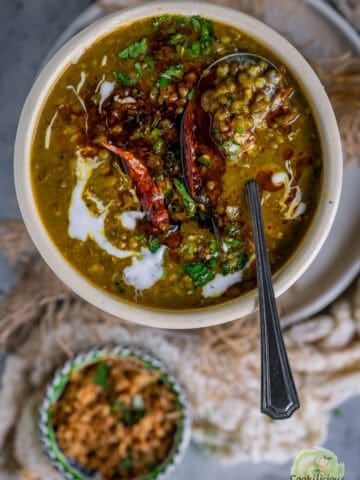
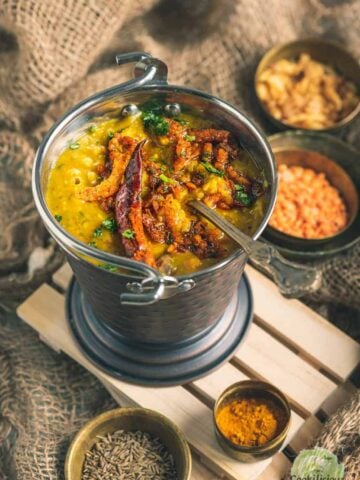
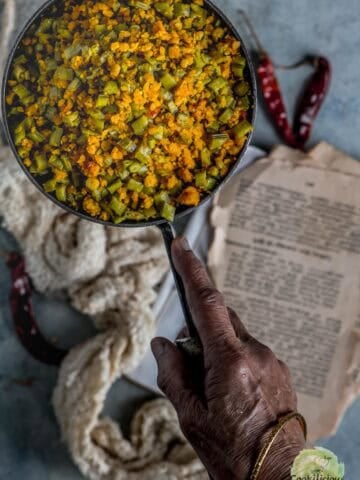
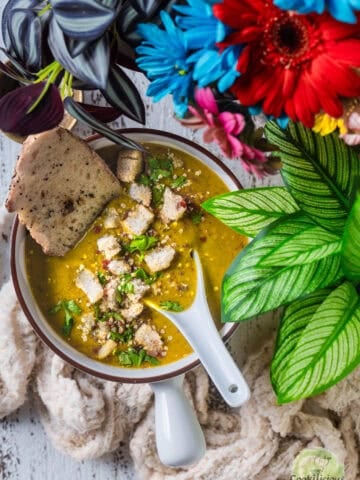


Kathy says
Found out too late that you can't substitute chipotle chili peppers for green chili's. It was too hot and I like hot. Still. Ended up simmering in some fresh garden tomatoes to calm it down. Will make it again in winter.
Priya says
Oh yes, next time reduce the chili a bit. But glad you liked it.